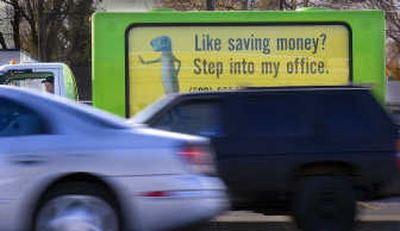Drive-by advertising

A vivid lime-green, diesel-powered truck regularly cruises the streets of Spokane, but it doesn’t deliver cargo. Instead, it carries a payload of three backlit, scrolling advertisements aimed to catch the eyes of motorists and onlookers. Every 10 seconds, a new ad measuring as much as 50 square feet appears on its left, right and rear walls.
Advertising long has dominated the sides of buses and delivery trucks. But this billboard-on-wheels, operated by GoGreen Mobile Media of Spokane, is among a growing nationwide deployment of trucks purely for marketing.
Mobile billboard operators tout them as a new way to capture consumers’ attention and build brand recognition.
“It generates kind of a response, I think, in the human brain – anything that moves, and it moves on two different fronts,” said Steve Cada, general manager of Samann Investments, which runs GoGreen.While roving billboards elsewhere have irked critics, who question burning scarce fossil fuels and contributing to traffic, operators contend they take steps to mitigate those effects, such as driving biodiesel-capable vehicles.
Last month, Kent, Wash.-based GoMobile Advertising brought one of its four similar trucks to Spokane. Yet instead of scrolling ads, the transparent-sided red and black vehicle displayed a scooter, chair and cello on pedestals to promote the latest Safeco Insurance campaign.
Advertising trucks are popular in Europe and Asia, said Mike Seifert, vice president of sales for GoMobile.
GoMobile also handles national sales and marketing for ad vehicles, which sell for about $100,000, for Florida truck maker Motionadz LLC. Affiliated trucks are operating in about 60 markets nationwide, including one each by operators in the Tri-Cities, Everett-Bellingham and Vancouver-Portland areas, Seifert said.
Transit-related billboards, including those on vehicles, comprised about $816 million, or 12 percent, of the $6.8 billion spent on outdoor advertising last year, according to the Outdoor Advertising Association of America.
GoGreen primarily competes with advertising on the side of buses and traditional static billboards, trying to offer competitive pricing, Cada said.
It costs $150 a week to advertise on one side, Cada said. The business claims a single billboard will be displayed more than 500 times a day and average more than 4,000 viewers.
Both GoGreen and GoMobile use public transportation data to determine what streets and intersections to frequent, operators said. The companies boast their trucks carry Global Positioning System devices, allowing clients to see where their ads are rolling at all times.
“We can position our vehicles in areas of the city that have a lot of traffic flow,” Cada said, noting the truck also is used at special events, such as parades. Operating for nearly a year, GoGreen owns two trucks purchased from a now-defunct Motionadz competitor but is waiting for more business before using the second, Cada said. The back of the truck was made in China and attached to an Isuzu chassis in the U.S., Cada said.
GoGreen uses a 60-inch printer to turn out ads on a Mylar-like material, Cada said. Inside the truck, a computer controls spools of ads that scroll past openings in the vehicle’s sides.
Although the GoGreen truck drives 40 hours a week on weekdays from about 11 a.m. to 7 p.m., it parks in key locations for two or three hours a day, Cada said.
Washington law prohibits “lighted or electrically powered” commercial signs or message boards attached to or displayed from vehicles on public roads, except for on taxis – a provision intended to “limit the confusion that lighted signs on vehicles can create.” GoGreen could park the lighted truck in some parking lots or on private property at night, said Washington State Patrol spokesman Trooper Mark Baker.
But Cada said initial research through the manufacturer indicated the way ads are backlit is allowed. When the vehicles were stopped by state and local police, only the backup camera was checked, he said.
“We have not had any problems, and I’ve not heard of anybody else having any problems as well,” he said, calling the light a “subtle glow.”
GoGreen’s truck can use biodiesel, but the company is waiting to find a local source, Cada said.
“We are aware of it, we’re sensitive to that,” Cada said of environmental concerns. “That’s one of the reasons we try to park our vehicles quite a few hours throughout the day.”
Although diesel has hit $3.50 a gallon on the West Coast, “We don’t have a huge fuel budget,” Cada said.
GoMobile trucks run on biodiesel where available, and the company is “very sensitive about traffic,” Seifert said.
Both companies run some charity ads, representatives said.
A local GEICO office, one of GoGreen’s advertisers, has received calls spurred by the truck ads, said Steve Garguile, local field representative.
“I’ve had a lot of people comment about it,” Garguile said, adding the monthly fee is “pretty fair.”
Seifert envisions 100 scrolling trucks on the road by the end of the year. GoMobile already has sold about $8 million of inventory for its manufacturer, and revenues have doubled year-over-year, he said.
Alternative media is “one of the categories that is in double-digit growth, and that’s why we chose to be here,” Seifert said.
“Because advertisers are looking for the next creative idea to really complement their traditional media.”